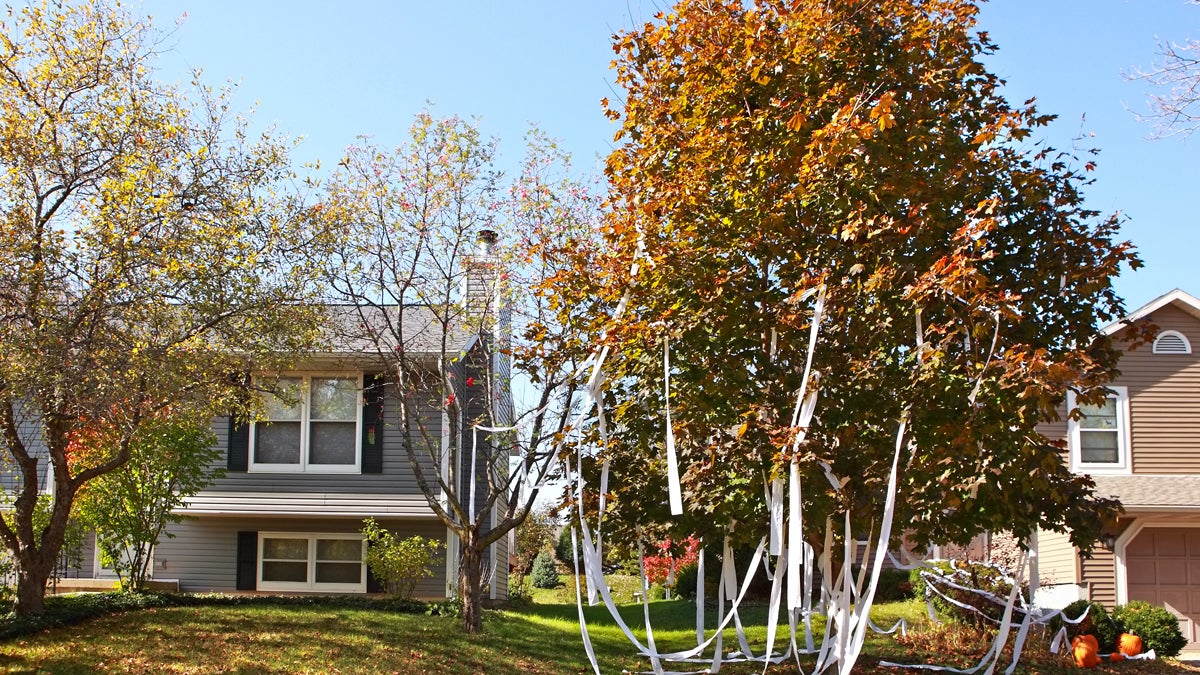Halloween and the new naughty
Listen Photo via ShutterStock) " title="toilet_paper_tree" width="1" height="1"/>
Photo via ShutterStock) " title="toilet_paper_tree" width="1" height="1"/>
In American cities and suburbs, Halloween used to be an evening for teenagers to make gentle mayhem.(Photo via ShutterStock)
In 1975, anthropologist Margaret Mead published a plaintive article about Halloween. It was once a night of youth rebellion, Mead wrote, when “children were granted to take mild revenge on the adults.” But the holiday had been tamed, leaving the grown-ups firmly in charge. “Where has all the mischief gone?” Mead asked.
Now it’s back, marketers tell us. Witness the boom in so-called “naughty” girls’ costumes, a centerpiece of the $8 billion Halloween seasonal industry. Seven- and eight-year-olds can trick-or-treat as sexy Snow Whites, sexy Dorothies, and even sexy Little Bo Peeps (don’t ask). And this season, Walmart has been selling a “Naughty Leopard” costume—complete with black lace and cabaret sparkles—for, yes, two-year-olds.
Tasteless? Yes. A threat to young girls’ body image? You bet. But “naughty”? Hardly. The sexy-costume trend reveals how far we have strayed from the truly naughty roots of Halloween, which used to be a time for kids to challenge their elders. Now it’s just another excuse to imitate adults, via the most American ritual of all: mass consumerism.
Born in Ireland as a Celtic end-of-summer festival, Halloween morphed into the Catholic celebration of “All Hallows Eve,” on the night before All Saints Day (November 1). Irish and Scottish immigrants brought it to America, where they re-enacted the costumed revelry of the old country. “The forests and dells of the United States are too cold and tramp-infested to be thickly populated with fairies and witches,” a New York newspaper quipped in 1878, reporting on a Halloween parade, “but American ingenuity has devised an acceptable substitute.”
By the turn of the century, Halloween had become an occasion for young men—of every ethnicity—to flout the rules of polite society. In 1900, medical students at the University of Michigan stole a headless female corpse from their anatomy laboratory and propped it against the front doors of their building. Seven years later, 31 Northwestern students were arrested for firing water hoses at divinity students on October 31.
In America’s burgeoning cities, meanwhile, teenagers used Halloween to make gentle mayhem. “This is the only evening on which a boy can feel free to play pranks outdoors, and it is his delight to scare passing pedestrians, ring door-bells, and carry off the neighbors’ gates,” one tickled columnist wrote.
Over the next few decades, however, Halloween hijinks devolved into much more serious vandalism. On “Black Halloween” of 1933, at the height of the Great Depression, hundreds of young men overturned automobiles, sawed down telephone poles, and taunted police. “It is an unregenerate sort of day needing redemption,” a Houston newspaper declared.
So schools and civic organizations began to sponsor parades and costume contests, as part of a nationwide drive for a “safe Halloween.” Meanwhile, parents started to accompany their children on house-to-house visits in search of candy.
The name of the new ritual—trick or treat—alluded to Halloween’s rough history. After World War II, however, most young Americans forgot it. “Beyond the stuffing of their pudgy stomachs, they didn’t know why they were filling their shopping bags,” sociologist Gregory Stone observed in 1959, after several trick-or-treaters came to his house. Halloween, he concluded, had become “a rehearsal for consumership.”
He was right. Candy companies manufactured special Halloween-themed products, which replaced the nuts, apples, and popcorn balls of earlier years. Ghosts, gypsies and other homemade outfits gave way to store-bought costumes like Howdy Doody, the first of many television and film characters to enter the Halloween pantheon.
And as TV and movies got racier, of course, so did the costumes. I started to notice this trend when my daughters were in elementary school, and one of their friends dressed up as Goldilocks. She wore long braids, of course, but also platform heels and a pencil-thin skirt. What would the Three Bears make of that?
Ten years later, thanks to the Internet, you can now find a sexed-up version of just about any costume you want. As a historian, I’m especially amused by “Pocahottie”—a nod to Pocahontas, of course, the Native American heroine. When Disney cast her in its 1995 animated movie, Pocahontas already looked like Barbie. Now she seems more like a porn star.
All of these costumes cling to narrow conventions of beauty, of course. And I do mean narrow: tiny sizes, lots of skin. Never mind that most American women don’t look anything like that, and never will. Halloween and Hollywood have become one and the same.
That brings us back to Margaret Mead, who wondered where all the mischief had gone. And now we know the answer: the grown-ups took it. They sold our kids to the highest bidder, who in turn sold all of us a bill of goods. There’s nothing naughty—or sexy–about an eight-year-old in a skimpy costume and high heels. But it’s also not her fault. It’s ours.
—
Editors note: A previous version of this story misidentified the date of All Saints’ Day.
WHYY is your source for fact-based, in-depth journalism and information. As a nonprofit organization, we rely on financial support from readers like you. Please give today.

